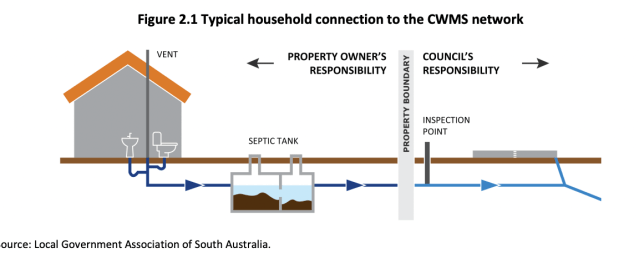A audit has identified a range of issues in the way South Australian councils are managing sewerage services.

South Australian Councils are by funded the state government to provide sewerage services in regional areas under the Community Wastewater Management Systems (CWMS) program, with 179 CWMS schemes managed by 48 of the 68 councils across the state.
State legislation allows councils to recover the full cost of operating and maintaining the CWMS from users of the service, but they are also required to manage their networks effectively so they can deliver required service levels, are financially sustainable and meet current and future community needs.
A report from the state’s auditor general focusing on two councils suggests some of this may not be happening.
The report notes that councils face significant challenges in managing CWMS networks, including responsibility for inspections and maintenance, unforeseen and uninsured events, regulation and compliance, keeping technology up to date and retaining and attracting specialist staff.
Challenges
SA auditor general Andrew Richardson assessed whether the Berri Barmera Council and the Yorke Peninsula Council were effectively managing their CWMS between 2018 and 2022.
Berri Barmera Council in the state’s Riverland region, about 220 km north-east of Adelaide, provides CWMS services to 3,184 residential customers and 490 non-residential customers.
Its $11.6 million CWMS network comprises six schemes across the council area with 31 pump stations and 119 kms of pipes.

The Council has a 25-year arrangement with a service provider to build, operate and maintain three wastewater treatment plants and three pump stations for treated wastewater, with ownership of the assets to be transferred to the Council in 2032.
Yorke Peninsula Council, 195 km north of Adelaide, provides CWMS services to 2,698 residential properties and 203 non-residential properties.
It has a network of 18 schemes with 41 pump stations, 17 wastewater treatment plants and 109 km of pipes, valued at $16.6 million.
Network management not up to scratch
The audit found both councils successfully removed and treated wastewater from properties in their networks.
However, it also identified issues in how both were managing their networks.
At Berri Barmera, the audit identified issues around asset management planning, maintenance, performance measurement, identifying and documenting risks and managing service providers.
“The Berri Barmera Council is not able to demonstrate that its CWMS network is being managed in a way that is financially sustainable over its useful life,” Mr Richardson found.
“This increases the risk of its CWMS network failing to provide a safe and reliable level of service in the medium to long term.”
The audit also concluded the council wasn’t able to demonstrate the network was being managed in a financially sustainable way, with a a likely funding shortfall of $4.6 million by 2030.
“This suggests that projected CWMS revenue will not cover the costs to operate and maintain the CWMS,” the report says.
Berri Barmera subsequently advised the auditor that revised forecasts suggested a $2.2 million shortfall, Mr Richardson noted.
York Peninsula, meanwhile, was found not to have effectively assessed the condition of all its CWMS network components, had gaps in the way it calculated service costs, hadn’t identified network management risks and was failing to report on the performance of the network against CWMS objectives.
However Mr Richardson noted that during the review periods York Peninsula had “progressively improved” its management framework.
Both councils have accepted the auditor’s recommendations for improvement.
Operating and capital costs of the CWMS network were $70 million in 2020-21, and CWMS income was $68 million including service charges, grants and developer contributions, the audit shows.





Leave a Reply